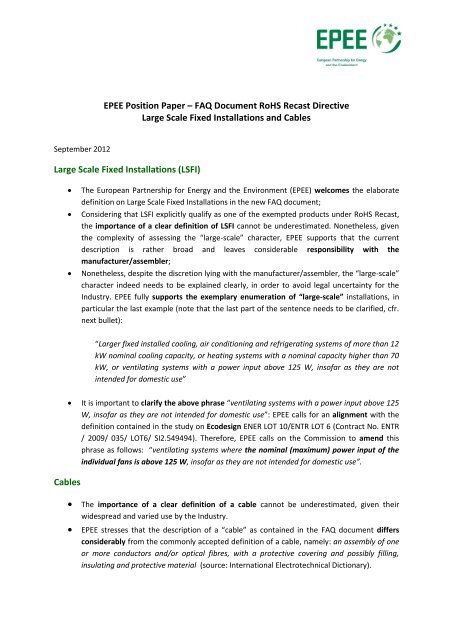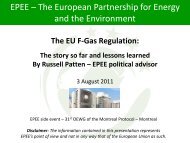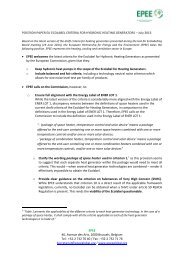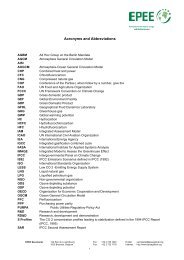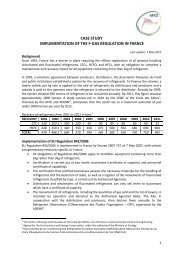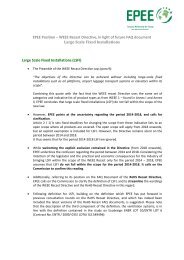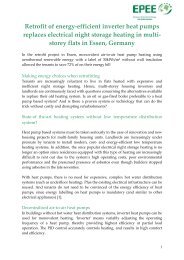EPEE Position Paper â FAQ Document RoHS Recast Directive ...
EPEE Position Paper â FAQ Document RoHS Recast Directive ...
EPEE Position Paper â FAQ Document RoHS Recast Directive ...
Create successful ePaper yourself
Turn your PDF publications into a flip-book with our unique Google optimized e-Paper software.
<strong>EPEE</strong> <strong>Position</strong> <strong>Paper</strong> – <strong>FAQ</strong> <strong>Document</strong> <strong>RoHS</strong> <strong>Recast</strong> <strong>Directive</strong><br />
Large Scale Fixed Installations and Cables<br />
September 2012<br />
Large Scale Fixed Installations (LSFI)<br />
<br />
<br />
<br />
The European Partnership for Energy and the Environment (<strong>EPEE</strong>) welcomes the elaborate<br />
definition on Large Scale Fixed Installations in the new <strong>FAQ</strong> document;<br />
Considering that LSFI explicitly qualify as one of the exempted products under <strong>RoHS</strong> <strong>Recast</strong>,<br />
the importance of a clear definition of LSFI cannot be underestimated. Nonetheless, given<br />
the complexity of assessing the “large-scale” character, <strong>EPEE</strong> supports that the current<br />
description is rather broad and leaves considerable responsibility with the<br />
manufacturer/assembler;<br />
Nonetheless, despite the discretion lying with the manufacturer/assembler, the “large-scale”<br />
character indeed needs to be explained clearly, in order to avoid legal uncertainty for the<br />
Industry. <strong>EPEE</strong> fully supports the exemplary enumeration of “large-scale” installations, in<br />
particular the last example (note that the last part of the sentence needs to be clarified, cfr.<br />
next bullet):<br />
“Larger fixed installed cooling, air conditioning and refrigerating systems of more than 12<br />
kW nominal cooling capacity, or heating systems with a nominal capacity higher than 70<br />
kW, or ventilating systems with a power input above 125 W, insofar as they are not<br />
intended for domestic use”<br />
Cables<br />
It is important to clarify the above phrase “ventilating systems with a power input above 125<br />
W, insofar as they are not intended for domestic use”: <strong>EPEE</strong> calls for an alignment with the<br />
definition contained in the study on Ecodesign ENER LOT 10/ENTR LOT 6 (Contract No. ENTR<br />
/ 2009/ 035/ LOT6/ SI2.549494). Therefore, <strong>EPEE</strong> calls on the Commission to amend this<br />
phrase as follows: “ventilating systems where the nominal (maximum) power input of the<br />
individual fans is above 125 W, insofar as they are not intended for domestic use”.<br />
The importance of a clear definition of a cable cannot be underestimated, given their<br />
widespread and varied use by the Industry.<br />
<strong>EPEE</strong> stresses that the description of a “cable” as contained in the <strong>FAQ</strong> document differs<br />
considerably from the commonly accepted definition of a cable, namely: an assembly of one<br />
or more conductors and/or optical fibres, with a protective covering and possibly filling,<br />
insulating and protective material (source: International Electrotechnical Dictionary).
Consequently, it is vital that the definitions given by the <strong>RoHS</strong> <strong>Recast</strong> <strong>Directive</strong> (Art. 3(5)<br />
<strong>RoHS</strong> <strong>Directive</strong>: cables means all cables with a rated voltage of less than 250 volts that serve<br />
as a connection or an extension to connect EEE to the electrical outlet or to connect two or<br />
more EEE to each other) are explained sufficiently clearly in the <strong>FAQ</strong> <strong>Document</strong>.<br />
<br />
<br />
The need for clarification is all the more relevant because cables were not part of the scope<br />
of <strong>RoHS</strong> I. Following Art. Article 2(2) of <strong>RoHS</strong> <strong>Recast</strong>, non-compliant EEE that were outside<br />
the scope of <strong>RoHS</strong> I but inside the scope of <strong>RoHS</strong> <strong>Recast</strong> must be granted full market access<br />
until 22 July 2019.<br />
<strong>EPEE</strong> suggests to clarify the definitions as follows:<br />
- Cables, in so far as they qualify under the definition given in this <strong>Directive</strong>, will fall within<br />
its scope from 22 July 2019 onwards.<br />
- Wiring that is contained within or integral to EEE does not meet the definition of "cable"<br />
given in Article 3(5). Instead, such wiring is part of the EEE and must therefore meet the<br />
material restrictions and timescale that apply to the EEE itself.<br />
- For EEE which is out of the scope of the <strong>RoHS</strong> <strong>Recast</strong> <strong>Directive</strong> due to exemption of<br />
article 2(4), wiring that is contained within or integral to such EEE are equally out of the<br />
scope of the directive.<br />
- Examples of EEE qualifying as a cable and thus falling under the <strong>Directive</strong> from 22 July<br />
2019 onwards are (this is a non-exhaustive list): the supply wire between the<br />
convenience outlet and the EEE and eventually external wire to connect accessories such<br />
as the printer, external hard drive.<br />
Regarding large scale fixed installations, <strong>EPEE</strong> calls upon the European Commission to maintain<br />
the wordings of the latest draft version of the <strong>FAQ</strong> document on the <strong>RoHS</strong> <strong>Recast</strong> <strong>Directive</strong>, be it<br />
with a clarification regarding ventilating systems (alignment with Ecodesign ENER LOT 10/ENTR<br />
LOT 6); regarding cables, <strong>EPEE</strong> stresses the need to clarify the definition of cables, as well as the<br />
rules determining whether or not a cable falls within the scope of the <strong>RoHS</strong> <strong>Recast</strong> <strong>Directive</strong>.<br />
About <strong>EPEE</strong>:<br />
The European Partnership for Energy and the Environment (<strong>EPEE</strong>) represents the refrigeration, airconditioning<br />
and heat pump industry in Europe. Founded in the year 2000, <strong>EPEE</strong>’s membership is<br />
composed of 40 member companies and national associations across Europe realising a turnover of<br />
over 30 billion Euros and employing more than 200,000 people in Europe. For more information,<br />
please visit our website: www.epeeglobal.org


